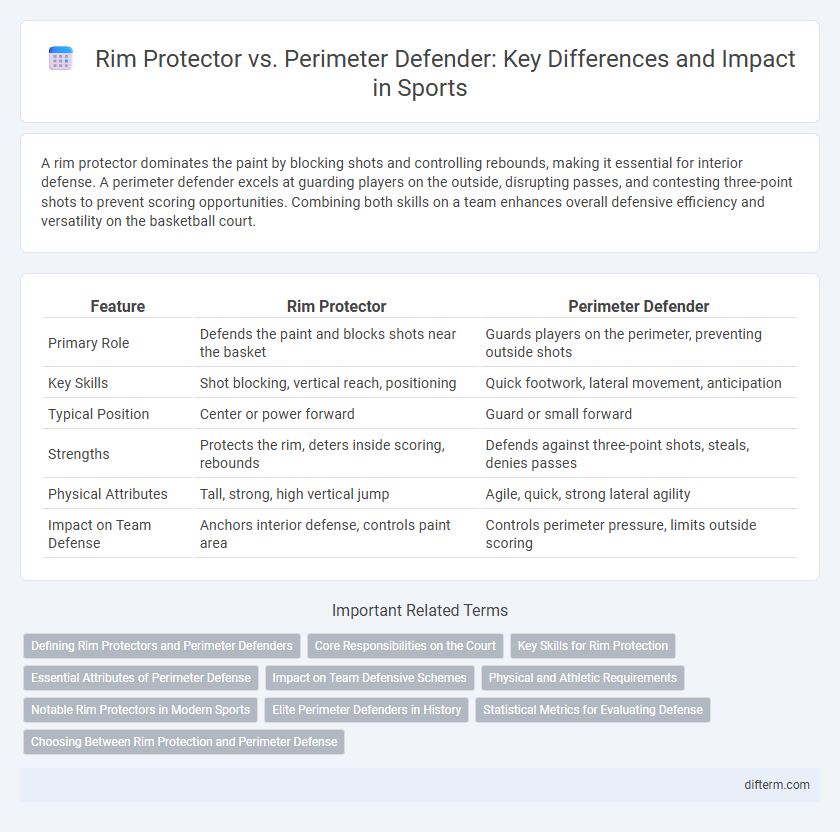A rim protector dominates the paint by blocking shots and controlling rebounds, making it essential for interior defense. A perimeter defender excels at guarding players on the outside, disrupting passes, and contesting three-point shots to prevent scoring opportunities. Combining both skills on a team enhances overall defensive efficiency and versatility on the basketball court.
Table of Comparison
| Feature | Rim Protector | Perimeter Defender |
|---|---|---|
| Primary Role | Defends the paint and blocks shots near the basket | Guards players on the perimeter, preventing outside shots |
| Key Skills | Shot blocking, vertical reach, positioning | Quick footwork, lateral movement, anticipation |
| Typical Position | Center or power forward | Guard or small forward |
| Strengths | Protects the rim, deters inside scoring, rebounds | Defends against three-point shots, steals, denies passes |
| Physical Attributes | Tall, strong, high vertical jump | Agile, quick, strong lateral agility |
| Impact on Team Defense | Anchors interior defense, controls paint area | Controls perimeter pressure, limits outside scoring |
Defining Rim Protectors and Perimeter Defenders
Rim protectors are defensive specialists who guard the area around the basket, using shot-blocking and rebounding skills to prevent opponents from scoring in the paint. Perimeter defenders focus on guarding players positioned beyond the three-point line, utilizing lateral quickness and anticipation to contest shots and disrupt ball movement. Both roles are essential in modern basketball defensive schemes, balancing interior presence with perimeter pressure.
Core Responsibilities on the Court
Rim protectors primarily focus on defending the paint by blocking shots, securing rebounds, and deterring opponents from driving to the basket, effectively anchoring the team's interior defense. Perimeter defenders excel at guarding outside shooters, applying pressure on ball handlers, and disrupting passing lanes to prevent scoring opportunities beyond the arc. Both roles require specialized skills that address different defensive needs, with rim protectors emphasizing interior presence and perimeter defenders prioritizing agility and anticipation on the perimeter.
Key Skills for Rim Protection
Rim protectors excel in shot-blocking, verticality, and timing to challenge close-range attempts effectively. They possess superior defensive rebounding skills and spatial awareness to control the paint and prevent second-chance points. Their agility and strength enable them to guard powerful post scorers while altering shots without fouling.
Essential Attributes of Perimeter Defense
Perimeter defenders excel in lateral quickness, anticipation, and closeout ability to effectively guard shooters and disrupt passing lanes beyond the three-point line. Essential attributes include exceptional footwork, strong on-ball pressure skills, and high defensive awareness to prevent perimeter scoring and force contested shots. Their agility and ability to navigate screens are critical for maintaining defensive integrity and triggering fast-break opportunities.
Impact on Team Defensive Schemes
Rim protectors anchor interior defense by deterring paint drives and securing rebounds, enabling teams to collapse and force opponents into contested outside shots. Perimeter defenders excel in disrupting ball handlers and shooters on the perimeter, allowing aggressive switching and trapping strategies that pressure opponents before they reach the paint. Balancing rim protectors and perimeter defenders enhances a team's versatility in switching defenses and helps in effectively containing both interior and perimeter threats.
Physical and Athletic Requirements
Rim protectors require exceptional height, wingspan, and explosive vertical leaping ability to effectively block shots and guard the paint. Perimeter defenders rely on quick lateral agility, endurance, and sharp footwork to stay in front of agile guards while contesting outside shots. Both roles demand elite physical conditioning, but rim protectors emphasize strength and timing, whereas perimeter defenders prioritize speed and reaction time.
Notable Rim Protectors in Modern Sports
Notable rim protectors in modern basketball, such as Rudy Gobert, Myles Turner, and Clint Capela, dominate the paint with exceptional shot-blocking and defensive rebounding skills, significantly altering opponents' interior scoring strategies. Their ability to protect the rim forces perimeter defenders to focus more on outside shooters and less on collapsing inside, creating a dynamic defensive balance. These players' defensive impact is quantifiable through advanced metrics like Defensive Win Shares and Block Percentage, highlighting their crucial role in team defense.
Elite Perimeter Defenders in History
Elite perimeter defenders in basketball, such as Bruce Bowen, Tony Allen, and Kawhi Leonard, are renowned for their ability to neutralize opposing scorers through tenacious on-ball pressure, lateral quickness, and high basketball IQ. Their skill set contrasts with rim protectors, who primarily focus on shot-blocking and rim deterrence, as perimeter defenders excel in disrupting outside shooting and creating turnovers on the perimeter. Historical defensive metrics and accolades, like multiple NBA All-Defensive Team selections, underscore the impact of elite perimeter defenders on team defensive efficiency and overall game strategy.
Statistical Metrics for Evaluating Defense
Rim protectors excel in blocks per game, opponent field goal percentage at the rim, and defensive rebounds, showcasing their impact in the paint. Perimeter defenders are measured by steals, deflections, contested three-point attempts, and defensive win shares, highlighting their ability to disrupt outside shooters. Advanced metrics such as Defensive Box Plus/Minus (DBPM) and Defensive Rating further quantify each defender's effectiveness in limiting opponent scoring opportunities.
Choosing Between Rim Protection and Perimeter Defense
Choosing between rim protection and perimeter defense hinges on team strategy and player matchups; rim protectors excel in blocking shots and altering inside scoring, while perimeter defenders disrupt outside shooting and ball movement. Investing in a versatile player capable of both rim protection and perimeter defense enhances defensive cohesion and adaptability against varied offensive threats. Teams emphasizing interior defense rely heavily on rim protectors to anchor the paint, whereas perimeter defense specialists are crucial against high-volume three-point shooting teams.
Rim Protector vs Perimeter Defender Infographic

 difterm.com
difterm.com